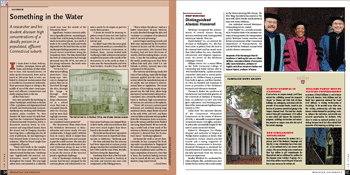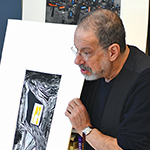Something in the Water
 It came down to hats: Fedoras, bowlers, stovepipes, fezzes, pillboxes, and dozens of other styles lost to time. Hat manufacturers, 50 miles up the Housatonic River and as much as 200 years back in time, are linked to chemical contamination that is recorded in Connecticut’s sediments. Their poisonous legacy is sitting in the middle of one of the state’s most populated and affluent communities and slowly seeping down to the sea.
It came down to hats: Fedoras, bowlers, stovepipes, fezzes, pillboxes, and dozens of other styles lost to time. Hat manufacturers, 50 miles up the Housatonic River and as much as 200 years back in time, are linked to chemical contamination that is recorded in Connecticut’s sediments. Their poisonous legacy is sitting in the middle of one of the state’s most populated and affluent communities and slowly seeping down to the sea.
All this from hats?
Hats were probably the last things in Johan Varekamp’s mind back in the late 1990s. A professor and department head of Earth and Environmental Sciences, Varekamp was working with Wesleyan students (John Crockett ’96, Bart Kreulen ’98, Kate Lauriat ’01) with funding from the Connecticut Department of Environmental Protection (DEP) to document mercury levels in Connecticut and Long Island Sound. Since the Sound and its fringing marshes have long been a collecting area for all sorts of pollutants, he was expecting to find elevated levels of mercury in the sediment. What he found caught him completely off guard.
“There were levels in the samples three to five times above what we considered normal for that area,” Varekamp says. “Significantly, the mercury contamination wasn’t spread evenly throughout the Sound. The very high values were concentrated in a relatively small area near the mouth of the Housatonic River.”
Significant, because mercury pollution is typically airborne, emanating primarily from coal-burning facilities and waste incineration plants. As a result, it tends to be carried by wind and evenly deposited over the land from the air. But Varekamp’s findings pointed to a waterbound source somewhere along the Housatonic River. The data showed that the level of contamination had strongly decreased since the 1970s, but even in the young sediments, the levels were higher than elsewhere.
“ Remember what we are talking about here,” Varekamp says. “Mercury is a dangerous poison that can be absorbed through the skin, through the lungs or through food. When someone drops a thermometer in a school room, that room is evacuated immediately for cleanup. And we were finding high concentrations in areas that are considered nature preserves!”
The Housatonic flows down from the Berkshire Mountains in Massachusetts and covers nearly 150 very crooked miles. It drops nearly 1,000 feet from its source, which is steeper than most New England rivers and accounts in part for a swift current. The river also takes on the water and sediments of several tributaries along its way to the Sound. Given these conditions, trying to locate the source of the mercury posed a significant challenge.
One of Varekamp’s students, Kate Lauriat, had become intrigued by the mercury plume and volunteered to initiate a search for its origins as part of a senior thesis project.
“I knew we would be weaving together a story of some sort, but I had no idea how daunting this would be,” Lauriat said.
An E&ES major who has since graduated and now works as a consultant for Geological Services Corporation in Hudson, Mass., Lauriat worked with Varekamp to take sediment and surface samples from points at the mouth of the Housatonic to as far north as Kent, a town near the Massachusetts and New York borders. Results from the Still River (near Danbury) area stopped them in their tracks, with concentrations that were even much higher than those found in the mouth of the river.
The levels we found were equivalent to what I have seen in SuperFund cleanup sites in California,” Varekamp said.
The data indicated that the mercury had been deposited at various points along a timeline that stretched from the late 1700s until the mid-1900s. But who had been doing the depositing?
Varekamp knew that a few hat-making shops were located in Danbury at one time, and mercury was once a key component in the felting process.
“That is where that phrase ‘mad as a hatter’ comes from,” he says. “Mercury is easily absorbed through the skin and ‘madness’ is a symptom of an advanced state of mercury poisoning.”
Lauriat began searching records and Web sites maintained by the Danbury Historical Society and the Housatonic Valley Association. She learned that Danbury had not been the home of merely a few hat-making shops—at one time, it was the hat-making capital of the world, producing more than three million hats each year. Until U.S. law forbade it (1940s), mercury was a key component in the process.
The mercury used during nearly 200 years of hat making, especially the large amounts applied near the turn of the century when the manufacturing was at its zenith, was not subject to environmental laws or regulations. The waste products of hat-making simply disappeared into the Still River, where large amounts of contaminated sediments accumulated. Also, around the old hat factories in Danbury, high concentrations of mercury are common in the uplands.
“These old mercury-contaminated sediments are mobilized during large rainstorm events. Major floods occurred in the early 1900s and 1955, and these mercury-laden sediments were propelled down the Housatonic River, to accumulate in the estuary and then were flushed into Long Island Sound. We are now taking a careful look at how much of the mercury in Western Long Island Sound sediment is derived from the Housatonic basin,” Varekamp explained.
He knows the work is not yet done. Currently, he has a proposal for funding under consideration to ‘fingerprint’ the sediments of the Housatonic basin by means of pollutant ratios and the isotopic composition of mercury. Once that is done, the Danbury hatting mercury may be traced all the way into the far western Long Island Sound.

